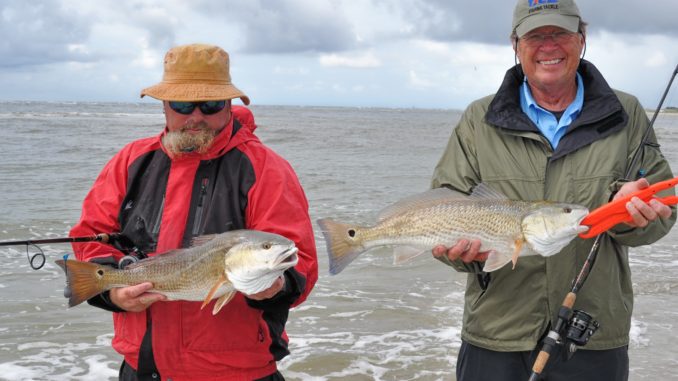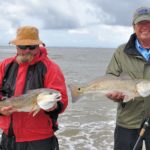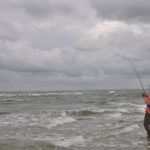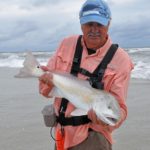
The breakers off barrier islands south of Swansboro, N.C., are full of redfish this month. Here’s how to find them and catch them.
Guide Dale Collins and anglers Rocky Carter of Swansboro, N.C., and John Moon of Graham, N.C., were casting 3-inch mullet chunks on Carolina rigs toward the churning surf. Within seconds, each angler was hooked up with an over-slot red drum that made rods bend and drags squeal. After battles that often took 10 minutes each, they released dozens of these broad-shouldered bronze fish.
“This is really what it’s all about,” said Carter, the vice president of the Coastal Conservation Association of North Carolina and founder of that group’s Onslow Bay chapter.
The three anglers, who had walked about 200 yards after beaching their boats near a coastal inlet south of Swansboro, would repeat their casts, catches, battles and redfish releases for two hours.
“This kind of fishing can happen here from September through February,” said Collins, 39, who runs Fish or Die Charters out of nearby Stella, N.C.
“I come down here a lot because the fishing is so much fun,” said Moore, who represents Haw River Tackle, which manufactures Stingsilver casting spoons, plus an assortment of soft-plastic baits.
And the fun is different from most winter inshore fishing along North Carolina’s coast. A majority of the state’s saltwater anglers don’t look forward to January, due to cold water and cold weather, windy days and the absence of almost all baitfish and most gamefish — long since bugged out to the south. But red drum still hang around in astoundingly large schools and are fun to catch.
Apparently, many redfish, especially the “rat reds” — under the state’s 18- to 27-inch slot limit — are homebodies, preferring to swim and eat in familiar surroundings. So they split their time between coastal creeks, marshes and bays or school in huge numbers just beyond the breakers. Inside, they prefer waters that are too shallow for their porpoises, their most-feared predators, and because the skinny waters are home to small crabs and mud minnows.
With no safety zone available on sandy ocean bottoms, redfish school for protection; they may gather in groups of 50 to 1,000 just off the beaches, giving the water an orange tint.
One advantage for anglers fishing in the surf zone is reds usually are upper-slot or larger. Heavier tackle and bigger lures work well because long-distance casts are less likely to spook redfish. They can be caught from boats by anglers casting toward the beach or from the surf, casting out.
Collins fishes from an 18-foot Alumacraft boat that uses to get to the marshes behind barrier islands south of Swansboro. He doesn’t take it through inlets, instead, beaching it on the back side and walking across to the breakers and casting from the suds.
“I learned over the years where to find reds in the surf,” Collins said. “They really start to move out of creeks and marshes toward the ocean in September when the first mullet blows push baitfish out of the sounds. You can catch reds and (speckled trout) in the ocean, right in the breakers and in the sloughs. You can use fish-finder rigs and cut mullet on Carolina rigs.
“But in winter, say, late December and early January, the water usually has cooled off to the point the baitfish all have left. You can find some mud minnows inside, but behind the breakers there won’t be hardly any baits, except for a few menhaden.
“That’s actually good news. If you can find a school of reds in the surf, they’ll be hungry…. They’ll hit grubs in December and January. Sometimes on calm days, you can even get them to attack topwater lures like Spooks.”
Another bit of good news is the beaches south of Cape Lookout are sheltered from colder winds from the northeast through the winter.
Dedicated anglers will walk, looking for redfish schools or deep holes off the beach and cast toward them.
“My favorite surf fishing around here is at inlets,” Collins said.
The surf north and south of Bogue Inlet and south along Bear Island to the north side of Bear Inlet can be productive. Fishing south of Bear Inlet on Browns Island is prohibited, the island posted by the U.S. Marine Corps, which often trains there.
“Lots of boaters come up or down the ICW and beach their boats at Hammocks Beach State Park (at Bear Island),” Collins said. “They walk east to the ocean to fish for reds and other fish.”
Best times to fish are during high and falling tides, but anglers should be aware that the surf north of inlets is often too shallow to hold fish because of the southerly sand migration.
Waders are basic equipment because of the waves and spray. A light, waterproof shell is a good addition.
Collins likes to walk the edge of the surf and look for sloughs that break up sandbars, place where fish congregate to look for food, or he’ll look for orange-tinted water just behind the breakers — “Sometimes a wave rolls, and you’ll see redfish in it,” he said — or fish cut baits on Carolina rigs in the sloughs when he’s blind-casting. Sloughs appear as areas of calmer water between the suds of breaking waves.
Collins likes to cast ¼-ounce Bluewater Candy jigheads with a variety of soft-plastic trailers, including 4-inch Gulp shrimp in sugar-spice glow or pearl-white colors, 6-inch Haw River sickle tails in chartreuse, 5-inch Zoom Jerk Shads in golden bream and 4-inch Gulp Shaky Shads in smelt color. A flip of the wrist will send a jighead soaring 50 to 75 yards, usually far enough to reach red drum.
“You want to put a lure in front of a school of fish, not splash it right in the middle of them because they’ll scatter,” he said.
If he’s blind-casting to sloughs, he’ll use Carolina rigs with 1- to 11/2-ounce barrel weights, 30-pound Yo-Zuri fluorocarbon leaders no more than 14 inches long, and mullet chunks on 3/0 circle hooks.
Collins, who works at Dudley’s Marina in Swansboro, doesn’t use traditional surf tackle. No 12-foot Hatteras Heavers, Ticas or Oceanmasters mated to Penn 525 reels for him.
“I use the same tackle I use in the boat fishing marshes and creeks for reds,” he said, describing 7-foot Star Seagis rods mated to Penn 4000 Conflict spinning reels spooled with 8- to 17-pound Power Pro braid.
DESTINATION INFORMATION
HOW TO GET THERE — I-40 and US 70 are the best routes to use to access Swansboro from points west. Using I-40, take Exit 373 (NC 24) to Jacksonville and Swansboro. Using US 70, take US 17 south from New Bern, then take NC 24 to Swansboro.
WHEN TO GO — Redfish are in the waters around Swansboro year-round, but the period from October through February offers the best fishing using artificial lures. Reds will bite in waters as cold as 38 degrees, and falling water temperatures in the marshes will push some of them into the ocean, which will usually be a few degrees warmer.
BEST TECHNIQUES — For reds in the surf zone, fish the northern sides of inlets where tides, winds and waves scour out “holes”. If water is clear, look for an orange tint just below the surface, indicating a school of reds. Cast artificial lures in front of moving fish, never in the middle of a school. If water is murky, cast 2- to 3-inch mullet strips with 1- to 11/2-ounce barrel sinkers and 14 inches of leader and 3/0 circle hooks to “sloughs” (calm water between breaking waves) or past sand bars running parallel to the shoreline. Reds can be found on beaches south of inlets on high tides.
FISHING INFO/GUIDES — Dale Collins, Fish or Die Charters, Stella, 252-422-4326; Robbie Hall, Hall ’Em In Charters, Swansboro, 910-330-6999; Rick Patterson, Cape Crusader Charters, Cape Carteret, 252-342-1513; Ricky Kellum, The Speckled Specialist, 910-330-2745, Jacksonville; Jeff Cronk, FishN4Life Charters 336-558-5697; Mike Taylor, Taylor Made Charters, Swansboro, 252-725-2633. See also Guides and Charters in Classifieds.
ACCOMMODATIONS — Waterway Inn, Swansboro, 252-393-8027; Best Western Plus Silver Creek Inn, Swansboro, 252-393-9015; Hampton Inn & Suites, Swansboro, 910-325-9000.
MAPS — Maps Unique, 910-458-9923, www.mapsunique.com; Sealake Fishing Guides, 800-411-0185, www.thegoodspots.com.








Be the first to comment